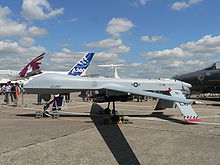General Atomics
MQ-1 Predator Drone
|
|||||||||||||||||||||||||||||||||
.
History General Atomics Aeronautical Systems, Inc.
General Atomics MQ-1 Predator
(often referred to as the Predator drone)
Manufactured 1995–2018

The General Atomics MQ-1 Predator (often referred to as the Predator drone) is an American remotely piloted aircraft (RPA) built by General Atomics that was used primarily by the United States Air Force (USAF) and Central Intelligence Agency (CIA). Conceived in the early 1990s for aerial reconnaissance and forward observation roles, the Predator carries cameras and other sensors. It was modified and upgraded to carry and fire two AGM-114 Hellfire missiles or other munitions. The aircraft entered service in 1995, and saw combat in the war in Afghanistan, Pakistan, the NATO intervention in Bosnia, the NATO bombing of Yugoslavia, the Iraq War, Yemen, the 2011 Libyan civil war, the 2014 intervention in Syria, and Somalia.
The USAF BIG SAFARI program office managed the Predator program and was directed on 21 June 2000 to explore armament options. This led to reinforced wings with munitions storage pylons, as well as a laser designator. The RQ-1 conducted its first firing of a Hellfire anti-tank missile on 16 February 2001 over a bombing range near Indian Springs Air Force Station north of Las Vegas, Nevada, with an inert AGM-114C successfully striking a tank target. Then on 21 February 2001 the Predator fired three Hellfire missiles, scoring hits on a stationary tank with all three missiles
-
Development

At Paris Air Show 2007 
A Predator flies on a simulated Navy aerial reconnaissance flight off the coast of southern California on 5 December 1995. The Central Intelligence Agency (CIA) and the Pentagon began experimenting with unmanned reconnaissance aircraft (drones) in the early 1980s. The CIA preferred small, lightweight, unobtrusive drones, in contrast to the United States Air Force (USAF). In the early 1990s, the CIA became interested in the "Amber", a drone developed by Leading Systems, Inc. The company's owner, Abraham Karem, was the former chief designer for the Israeli Air Force, and had immigrated to the U.S. in the late 1970s. Karem's company went bankrupt and was bought by a U.S. defense contractor, from whom the CIA secretly bought five drones (now called the "Gnat"). Karem agreed to produce a quiet engine for the vehicle, which had until then sounded like "a lawnmower in the sky". The new development became known as the "Predator"
Photo Gallery
General Atomics Aeronautical Systems, Inc.
General Atomics MQ-1 Predator (often referred to as the Predator drone)
Manufactured 1995–2018


General Atomics Aeronautical Systems, Inc.
General Atomics MQ-1 Predator Drone
General Info
-
-
- Crew: 0, 3 on ground out of theater, (remote pilot, sensor operator, and intelligence analyst), with in-theater ground handling crew
- Length: 27 ft 0 in (8.23 m)
- Wingspan: 48 ft 7 in (14.8 m) ::::MQ-1B Block 10/15: 55.2 ft (16.84 m)
- Height: 6 ft 11 in (2.1 m)
- Wing area: 123.3 sq ft (11.45 m2)
-
General Info
-
-
- Gross weight: 2,249 lb (1,020 kg)
- Fuel capacity: 851 lb (387 kg)
- Powerplant: 1 × Rotax 914F 4-cylinder air-cooled turbocharged horizontally-opposed piston engine, 115 hp (86 kW)
-
General Info
- Maximum speed: 217 km/h)
- Cruise speed: 130 km/h) to 90 kn (100 mph; 170 km/h)
- Stall speed: (62 mph, 100 km/h)
- Range: (777 mi, 1,250 km)
- Endurance: 24 hours
- Service ceiling: (7,600 m)
Armament
-
-
-
Hardpoints: 2 , with provisions to carry combinations of:
-
Missiles:
- 2 × AGM-114 Hellfire (MQ-1B)
- 4 × Air-to-Air Stinger (ATAS) (MQ-1B)
- 6 × AGM-176 Griffin air-to-surface missiles
-
Missiles:
-
-
.
(Called the Predator Drone)
Links to Youtube & Others
The General Atomics "Predator B-001", a proof-of-concept aircraft, first flew on 2 February 2001. Abraham Karem is the designer of the Predator.
General Atomics
MQ-1 Predator
MQ-9 Reaper crews (pilots and sensor operators), stationed at bases such as Creech Air Force Base, near Las Vegas, Nevada,
Youtube Link
As of 2018 the USAF had taken delivery of 287 out of 366 MQ-9 Reapers on contract with General Atomics















